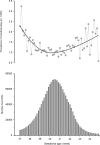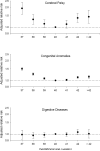Cerebral palsy among term and postterm births
- PMID: 20810375
- PMCID: PMC3711561
- DOI: 10.1001/jama.2010.1271
Cerebral palsy among term and postterm births
Abstract
Context: Although preterm delivery is a well-established risk factor for cerebral palsy (CP), preterm deliveries contribute only a minority of affected infants. There is little information on the relation of CP risk to gestational age in the term range, where most CP occurs.
Objective: To determine whether timing of birth in the term and postterm period is associated with risk of CP.
Design, setting, and participants: Population-based follow-up study using the Medical Birth Registry of Norway to identify 1,682,441 singleton children born in the years 1967-2001 with a gestational age of 37 through 44 weeks and no congenital anomalies. The cohort was followed up through 2005 by linkage to other national registries.
Main outcome measures: Absolute and relative risk of CP for children surviving to at least 4 years of age.
Results: Of the cohort of term and postterm children, 1938 were registered with CP in the National Insurance Scheme. Infants born at 40 weeks had the lowest risk of CP, with a prevalence of 0.99/1000 (95% confidence interval [CI], 0.90-1.08). Risk for CP was higher with earlier or later delivery, with a prevalence at 37 weeks of 1.91/1000 (95% CI, 1.58-2.25) and a relative risk (RR) of 1.9 (95% CI, 1.6-2.4), a prevalence at 38 weeks of 1.25/1000 (95% CI, 1.07-1.42) and an RR of 1.3 (95% CI, 1.1-1.6), a prevalence at 42 weeks of 1.36/1000 (95% CI, 1.19-1.53) and an RR of 1.4 (95% CI, 1.2-1.6), and a prevalence after 42 weeks of 1.44 (95% CI, 1.15-1.72) and an RR of 1.4 (95% CI, 1.1-1.8). These associations were even stronger in a subset with gestational age based on ultrasound measurements: at 37 weeks the prevalence was 1.17/1000 (95% CI, 0.30-2.04) and the relative risk was 3.7 (95% CI, 1.5-9.1). At 42 weeks the prevalence was 0.85/1000 (95% CI, 0.33-1.38) and the relative risk was 2.4 (95% CI, 1.1-5.3). Adjustment for infant sex, maternal age, and various socioeconomic measures had little effect.
Conclusion: Compared with delivery at 40 weeks' gestation, delivery at 37 or 38 weeks or at 42 weeks or later was associated with an increased risk of CP.
Figures


Similar articles
-
Risk of cerebral palsy in relation to pregnancy disorders and preterm birth: a national cohort study.Dev Med Child Neurol. 2014 Aug;56(8):779-85. doi: 10.1111/dmcn.12430. Epub 2014 Mar 13. Dev Med Child Neurol. 2014. PMID: 24621110 Free PMC article.
-
Is vaginal breech delivery associated with higher risk for perinatal death and cerebral palsy compared with vaginal cephalic birth? Registry-based cohort study in Norway.BMJ Open. 2017 May 4;7(4):e014979. doi: 10.1136/bmjopen-2016-014979. BMJ Open. 2017. PMID: 28473516 Free PMC article.
-
Assessing the neuroprotective benefits for babies of antenatal magnesium sulphate: An individual participant data meta-analysis.PLoS Med. 2017 Oct 4;14(10):e1002398. doi: 10.1371/journal.pmed.1002398. eCollection 2017 Oct. PLoS Med. 2017. PMID: 28976987 Free PMC article.
-
Cerebral palsy: phenotypes and risk factors in term singletons born small for gestational age.Eur J Paediatr Neurol. 2015 Mar;19(2):218-25. doi: 10.1016/j.ejpn.2014.12.005. Epub 2014 Dec 17. Eur J Paediatr Neurol. 2015. PMID: 25596065
-
Investigating the association between maternal age and cerebral palsy incidence: A meta-analysis.Medicine (Baltimore). 2025 May 23;104(21):e42568. doi: 10.1097/MD.0000000000042568. Medicine (Baltimore). 2025. PMID: 40419867 Free PMC article.
Cited by
-
Risk factors of cerebral palsy in children: a systematic review and meta-analysis.Transl Pediatr. 2022 Apr;11(4):556-564. doi: 10.21037/tp-22-78. Transl Pediatr. 2022. PMID: 35558974 Free PMC article.
-
Impact of gestational age on risk of cerebral palsy: unravelling the role of neonatal morbidity.Int J Epidemiol. 2022 Jan 6;50(6):1852-1863. doi: 10.1093/ije/dyab131. Epub 2021 Jun 28. Int J Epidemiol. 2022. PMID: 34999876 Free PMC article.
-
Cerebral palsy and gestational age.Rev Obstet Gynecol. 2010 Fall;3(4):194. Rev Obstet Gynecol. 2010. PMID: 21364856 Free PMC article. No abstract available.
-
Optimal timing for elective caesarean delivery in a Chinese population: a large hospital-based retrospective cohort study in Shanghai.BMJ Open. 2017 Jun 8;7(6):e014659. doi: 10.1136/bmjopen-2016-014659. BMJ Open. 2017. PMID: 28600366 Free PMC article.
-
APPEARANCE OF NEURODEVELOPMENTAL DISORDERS IN CHILDREN DELIVERED POST-TERM: A CROSS-SECTION STUDY.Mater Sociomed. 2016 Apr;28(2):99-103. doi: 10.5455/msm.2016.28.99-103. Epub 2016 Mar 25. Mater Sociomed. 2016. PMID: 27147913 Free PMC article.
References
-
- Mesterman R, Leitner Y, Yifat R, et al. Cerebral Palsy--Long-Term Medical, Functional, Educational and Psychosocial Outcomes. J Child Neurol. 2010;25(1):36–42. - PubMed
-
- Krageloh-Mann I, Cans C. Cerebral palsy update. Brain Dev. 2009;31(7):537–544. - PubMed
-
- Pakula AT, Van Naarden Braun K, Yeargin-Allsopp M. Cerebral palsy: classification and epidemiology. Phys Med Rehabil Clin N Am. 2009;20(3):425–452. - PubMed
-
-
Rosenbaum P, Paneth N, Leviton A, et al. A report: the definition and classification of cerebral palsy April 2006. Dev Med Child Neurol Suppl. 2007;109:8–14. [Erratum, Dev Med Child Neurol. 2007;49(6):480.]
-
-
- Nelson KB. Preventing cerebral palsy: paths not (yet) taken. Dev Med Child Neurol. 2009;51(10):765–766. - PubMed
Publication types
MeSH terms
Grants and funding
LinkOut - more resources
Full Text Sources
Other Literature Sources
Medical
Miscellaneous

